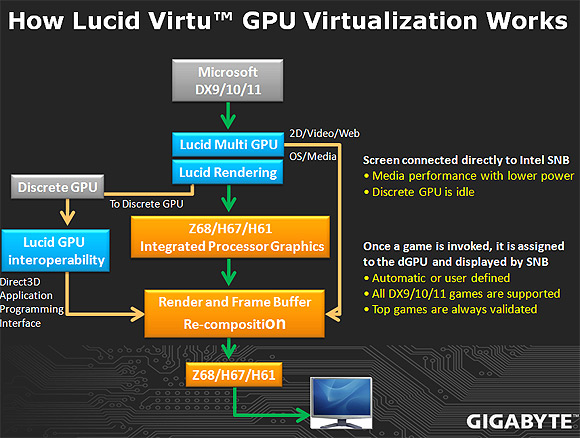Lucid's VIRTU is a software driver Intel validated for the
Intel Z68 platform that enables on-the-fly switching between discreet graphics cards
and Sandy Bridge's integrated DX10.1 Intel HD3000/2000 graphics core by
virtualizing one video output through the other.

There are two ways
of configuring VIRTU. If the monitor is connected to the
motherboards graphics ports (ie. HDMI, DP, DVI-D) and a discrete videocard
is installed, VIRTU can virtualize the discreet videocard (i-Mode) when 3D games
are launched.
Conversely, if
the monitor is connected to a discrete videocard, VIRTU can virtualize the
CPU-IGP when required (d-Mode). All this is done on the fly without moving
monitor cables.
|

Gigabyte's GA-Z68X-UD3H-B3
motherboard is validated for Lucid's VIRTU
driver.
|
The key to Virtu is that it enables the
Intel HD 3000/2000 IGP to accelerate video transcoding tasks via Intel
QuickSync, or HD-BluRay streaming via Intel Insider, then when needed seamlessly switch to purpose bred
discreet videocards for 3D gaming (with DX11 and AA as the case
may be). PCSTATS tested with VIRTU
v1.1.101.16713 and found a negligible impact to 3D benchmark results with
it running; VIRTU is pretty simple to use and can be tasked to kick in
for specified applications. VIRTU works with
all Intel Z68 motherboards, but only if the board has onboard
video outputs.
Intel Smart
Response Technology
Intel Smart Response Technology is pretty interesting. In plain
language, what Intel SRT does is bring about like-SSD performance to operating
systems and applications installed on traditional mechanical SATA hard drives
by storing frequently accessed hard drive I/O data blocks on a dedicated SSD
drive. Frequently accessed data can be read much quicker from the SSD, so Windows 7 spends
less time waiting around.
The system is compatible with mSATA and standard SATA SSD
devices; PCSTATS has tested Intel SRT already with an mSATA Intel Larson Creek 311 SSD
and a Intel
SSDSA2VP020G2 2.5" solid state drive made with 34nm SLC 'Compute NAND' memory,
so we're not going to re-hash all the results here.
Suffice to say, for computers with Windows 7/Vista
installed to a traditional mechanical hard drive, Intel SRT is an economical way
to speed up application load times and generally make recurring application data
much snappier. In general, Intel SRT will
fully kick in on the second and subsequent instances an application is used. The tool
doesn't work on systems already installed to an SSD, and really works best on the
boot disk/volume. For an in-depth look at Intel SRT please see this PCSTATS article.
Moving along, it's time for a 360-degree look
at the Gigabyte GA-Z68X-UD3H-B3 motherboard!
